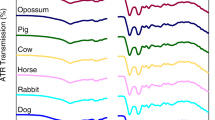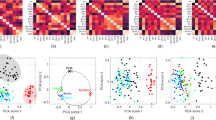Abstract
THE determination of haptoglobin types in dried bloodstains has until recently met with very limited success. The method for determining haptoglobin types using starch gel1–4 is the most satisfactory technique available for serum samples. Direct transposition of this technique to bloodstains has been tried by many research workers5–7 both in starch and acrylamide gels. The patterns obtained from stain material differ considerably from those shown by fresh serum samples. It is extremely difficult to interpret the results as they can be obscured by the excess haemoglobin present and it can only be done if the stain is very fresh (that is, not more than about 3 days old). The problem of excess haemoglobin can be overcome by subjecting the sample to a short preliminary electrophoresis in starch gel at pH 6.5 (tank buffer: 0.04 M disodium hydrogen phosphate adjusted to pH 6.5 with ortho-phosphoric acid; gel buffer: 20 ml. tank buffer diluted to 150 ml.). At this pH, haemoglobin moves towards the cathode while the haptoglobin/haemoglobin complex moves towards the anode. After 30 min electrophoresis at 6 V/cm, a block of gel about 1 cm2 is removed on the anodic side of the origin and inserted into a gel at pH 8.6 with a buffer system according to Poulik4. However, we required a method which was accurate and would allow the determination of haptoglobin types in stains at least one month old. These conditions have been met by using an immuno-electrophoresis method.
This is a preview of subscription content, access via your institution
Access options
Subscribe to this journal
Receive 51 print issues and online access
$199.00 per year
only $3.90 per issue
Buy this article
- Purchase on Springer Link
- Instant access to full article PDF
Prices may be subject to local taxes which are calculated during checkout
Similar content being viewed by others
References
Smithies, O., Biochem. J., 61, 629 (1955).
Smithies, O., Nature, 175, 307 (1955).
Smithies, O., and Walker, M. F., Nature, 176, 1265 (1955).
Poulik, M. D., Nature, 180, 1477 (1957).
Culliford, B. J., Nature, 198, 796 (1963).
Gervais, P., and Viescou, Cl., Ann. Med. Leg. (1965).
Migauchi, C., Rep. Nat. Res. Inst. Police Sci., Tokyo, 17, 3 (1964).
Hirschfeld, J., Sci. Tools, 7, 2 (1960).
Hallermann, W., Kiwi, M., and Sturner, K. H., Dtsch. Z. ges. gerichtl. Med., 54 (1963).
Author information
Authors and Affiliations
Rights and permissions
About this article
Cite this article
CULLIFORD, B., WRAXALL, B. Haptoglobin Types in Dried Bloodstains. Nature 211, 872–873 (1966). https://doi.org/10.1038/211872a0
Issue Date:
DOI: https://doi.org/10.1038/211872a0
This article is cited by
Comments
By submitting a comment you agree to abide by our Terms and Community Guidelines. If you find something abusive or that does not comply with our terms or guidelines please flag it as inappropriate.



